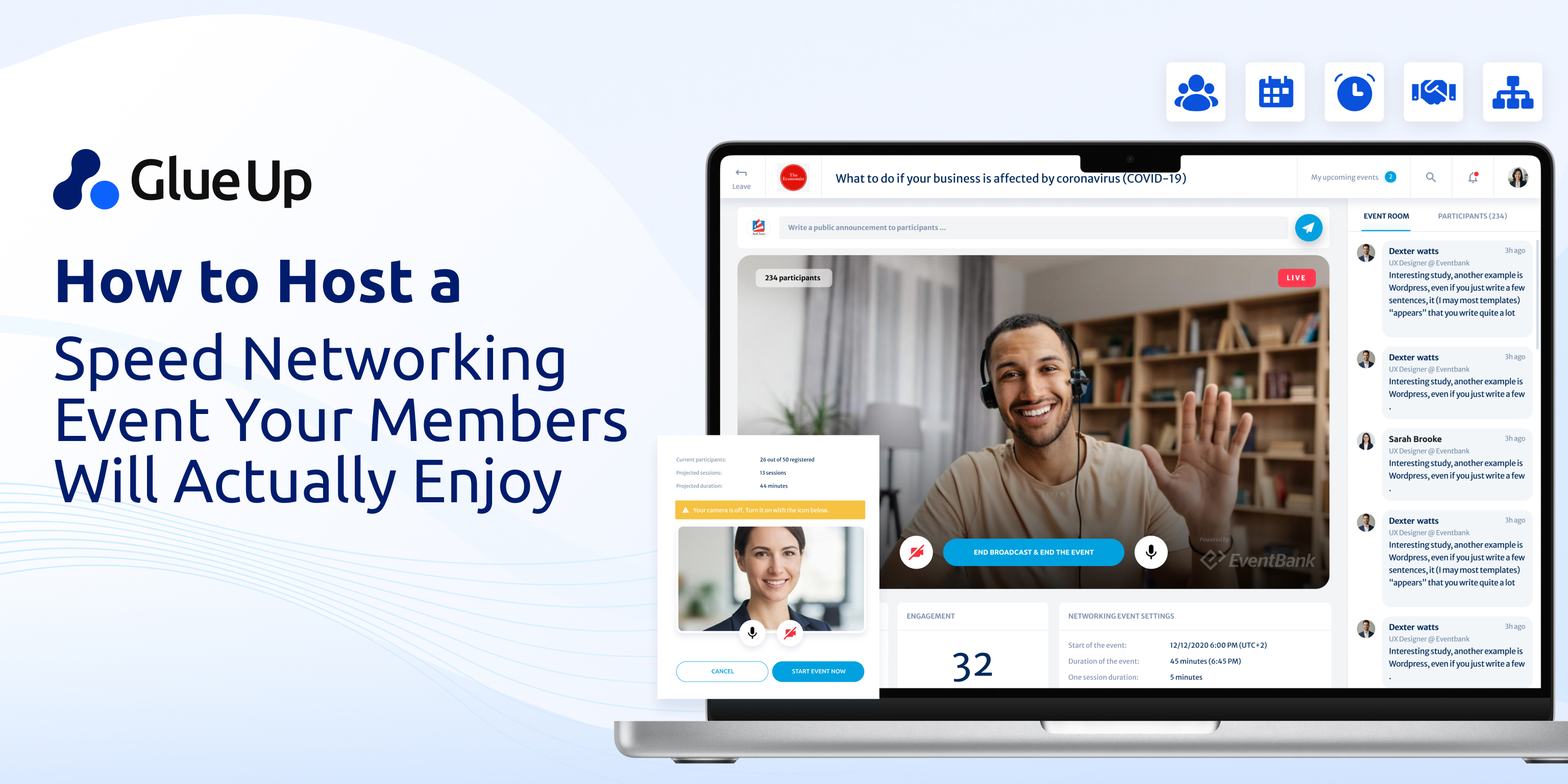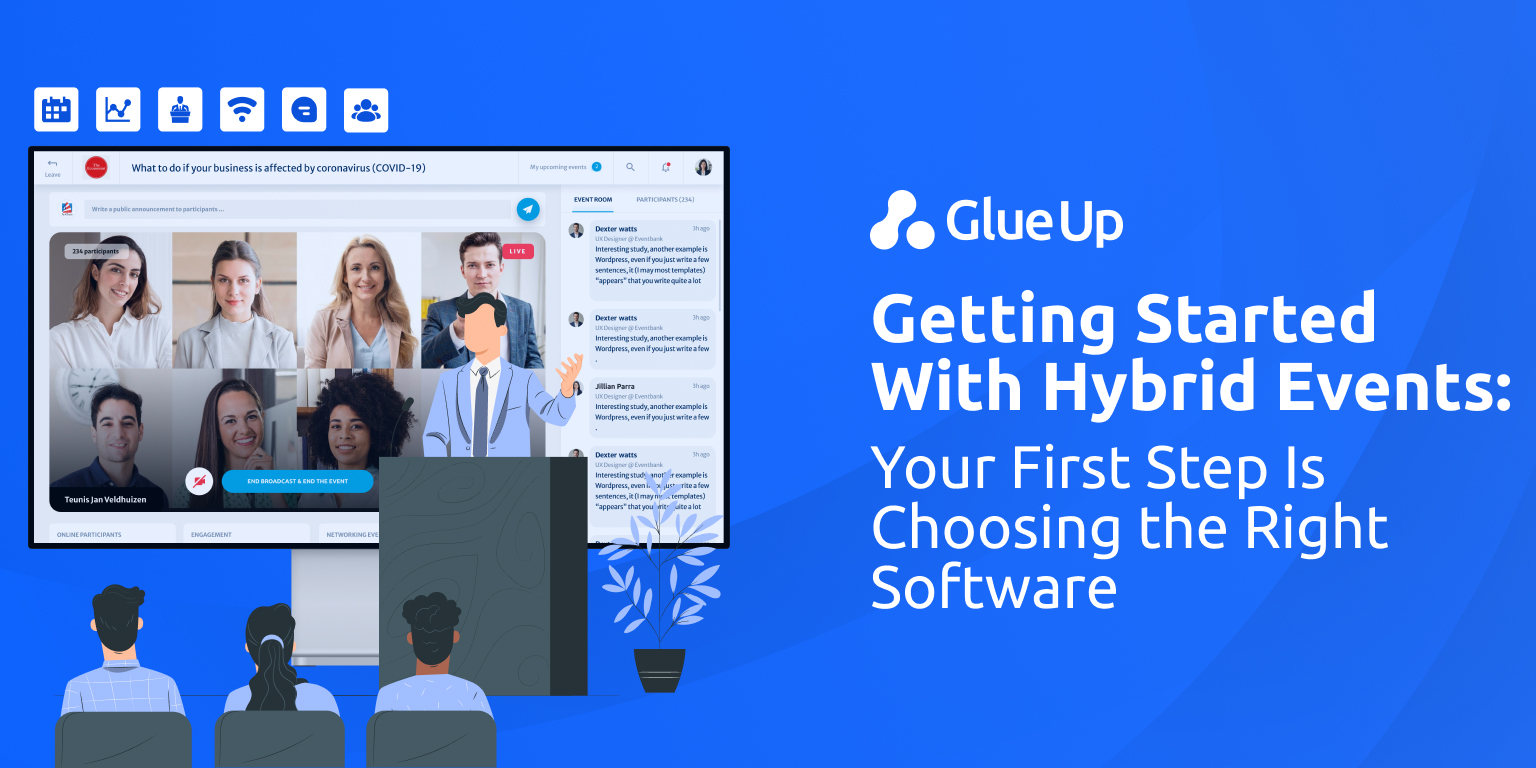
Speed networking event hosting works when it feels less like musical chairs and more like a string of meaningful first meetings your members actually asked for. The rounds are short, the cues are clear, and the follow ups are easy to book.
What separates awkward from effective is not charisma. It is design. This guide gives you the run of show, the matching rules, the prompts, and a sponsor ready scorecard you can lift today. You will see where speed networking event hosting fits in your calendar, how to make it friendly for shy attendees, how to set sponsor expectations, and how to measure what matters. If you do it right, speed networking event hosting will become the most reliable hour in your program for creating next steps people follow through on.
Key Takeaways
Pick 5–7 measurable outcomes (e.g., follow-ups booked, sponsor high-fit meetings), assign owners, and weight them on a one-page scorecard. That clarity drives every decision in the room.
Use proven structures, 1:1 rotations, small-table triads/quads, or mentor rounds, at 3–6 minutes per meeting with a firm bell, visible timer, table flags, and clear wayfinding.
Collect a few fields at registration (role, function, two interests, objective, buyer/supplier, chapter, mentoring). Prioritize new members early, guarantee sponsors a set number of high-fit conversations, and rotate across functions.
Treat follow-up as the product: QR codes for one-tap contact capture, a default “yes” to schedule 15-minute check-ins, and a 24-hour recap email listing matches, notes, and booking links.
Track more than headcount, average meetings per attendee, qualified match rate, follow-ups within 48 hours, sponsor fulfillment, and member sentiment, then roll it up for a board- and sponsor-ready report.
Quick Reads
Speed Networking Questions for Professional Events • Glue Up
Post-Event Evaluation: Events Into Smarter Futures • Glue Up
26 Networking Event Ideas for Chambers of Commerce | Glue Up
10 Tips for Successful Networking at a Virtual Event • Glue Up
Define Success Before Speed Networking Event Hosting Starts
A good event begins with a useful definition of success. Before you reserve a room, decide what a good match means for your members, your sponsors, and your team.
Pick outcomes you can verify. For example,
A new member meets two peers who share their function, then books one follows up within 48 hours
A sponsor has six conversations with budget holders who match an ideal customer profile
A chapter lead finds two volunteers for a working group, each with relevant skills
Write five to seven outcomes. Assign an owner for each outcome. Give each outcome a weight on a simple one page scorecard. If you weight sponsor fulfillment at 30 percent, and follow ups booked at 25 percent, your staff knows what to prioritize when tradeoffs appear.
Make the path visible. Publish your definition of success in your internal run of show. Add one slide for staff and volunteers that says what a good match looks like. If people know the bar, they aim for it.
Set the expectation with attendees. In the registration confirmation, include a simple line. “You will have short meetings with clear prompts. The goal is to book one useful follow up.” You just told people how to behave. That is free behavior design.
Formats For Speed Networking Event Hosting That Work
Most formats fail because they ask people to do too much in too little time. Keep your format simple, predictable, and kind. Three formats work across associations and chambers.
Classic one to one rotation.
Four to six minutes per round
Thirty second warnings, then a clear bell or chime
Everyone rotates in the same direction to the next numbered station
This format favors breadth. Members meet many people, and your job is to make follow ups easy.
Small table sprints.
Triads or quads at numbered tables
People rotate tables instead of chairs
A printed card sets the prompt for that round
This format enables light peer learning and makes sponsor discovery feel natural. Place sponsor hosts as anchors at specific tables if needed.
Mentor rounds.
Senior anchors stay seated
Members rotate between anchors
Each round focuses on a topic like membership operations, policy, or sponsorships
This format is strong for onboarding new members and connecting them with credible guides.
Timing guardrails.
Do not extend rounds beyond six minutes. Energy drops, and small talk grows. Three to five minutes plus a hard stop keeps momentum, keeps people honest, and prevents fatigue. Signal the last thirty seconds, then end on time. People respect clarity.
Matching Rules for Speed Networking Event Hosting
Randomness is not serendipity. Light structure raises hit rates without creating an administrative burden.
Collect just enough data.
Add these fields to your registration form.
Role or seniority
Primary function
Two interests from a short list
Objective for attending
Buyer or supplier flag
Chapter or region
Mentoring preference
Use simple logic.
New members go first in the first two rounds, then enter the general rotation
Sponsors receive a guaranteed number of high fit conversations with a clear definition of fit
People rotate across functions to avoid same table clustering unless a track is requested
Members can opt into a mentor track, a vendor discovery track, or a peer exchange track
Respect purpose.
If your event theme is advocacy, cluster a few early rounds by policy interest, then open up for breadth. If your theme is vendor discovery, make the early rounds buyer supplier, then rotate to peer to peer so no one feels sold to for the entire hour.
Introvert Friendly Speed Networking Event Hosting
Structure is kindness. Make the experience predictable, calm, and choice rich.
Publish the plan. In pre-event communications, share the number of rounds, the round length, and the rotation pattern. People who prefer predictability will read it, relax, and show up prepared.
Create a quiet landing zone. Offer a low stimulus area for arrival and short breaks. A few chairs away from speakers and a visible timer is enough.
Place conversation cards at every station. People should never have to invent a question under pressure. Use prompts that surface value fast.
What member problem are you trying to solve this quarter
What would make your renewal a clear yes
Which event tactic actually moved the needle this year
What is one vendor you recommend without reservation
Add micro breaks. Every twenty to thirty minutes, give three to four minutes for water, notes, and quick calendar checks. Breaks maintain energy and increase follow through.
Train the room. Give your MC a simple script. “Start with names and roles. Go straight to one prompt. If the fit is good, scan the QR code to book a quick follow up. The bell is firm. That is how we help everyone meet the right people.”
The Ninety Minute Run of Show for Speed Networking Event Hosting
Here is a practical schedule you can copy. It assumes in person delivery with a room of 24 to 36 participants and a few sponsors.
T minus 10 to 0 minutes.
Quiet arrival, badge pickup with names and three-word tags for function, interest, and goal. A large screen shows a looped slide with the rotation map and a visible timer. Staff stands near the entrance to direct people to tables.
0 to 5 minutes.
MC welcome, what a good match looks like, quick timer demo. Make the ask explicit. “Your job is to book one useful follow up. Use the prompt cards. The bell is firm.”
5 to 35 minutes.
Rounds one through six. Five minutes per round. Thirty second warnings. Hard stop.
35 to 39 minutes.
Micro break. Water, notes, calendar checks. Staff moves late arrivals into the rotation.
39 to 69 minutes.
Rounds seven through twelve.
69 to 75 minutes.
Open mingle, sponsor perimeter tables for opt in visits. Place a staff member near sponsors with the sponsor fulfillment sheet.
75 to 80 minutes.
Close and thank you. Tell attendees they will receive a recap of their matches, the notes they entered, and links to book fifteen-minute check ins within twenty-four hours.
Room layout tips.
Numbered stations in a simple loop
Table flags that are visible above seated heads
Floor arrows that show rotation direction
Sponsors on the perimeter, not in the flow, so attendees can opt in
Staffing model.
MC, floor captain, timekeeper, sponsor concierge
One volunteer greeter, one runner for last minute changes
This is the same backbone you will use across chapters. It scales because it is simple.
Virtual And Hybrid Speed Networking Event Hosting
Virtual and hybrid formats expand reach and reduce cost, but they require tighter pacing and stronger facilitation.
Shorten the rounds. Cap virtual rounds at three to four minutes. Cap total time at forty-five to sixty minutes. Attention and posture are different on a screen. Match the medium.
Clarify roles. Assign a host, a timekeeper, and a chat moderator. The host welcomes, the timekeeper keeps the bell honest, the moderator gathers questions and posts prompts to chat.
Rehearse the tech. Two days before the event, send a device and audio check note to registered members. Give simple instructions with screenshots, not long text.
Use breakouts that mirror your tracks. If you have a mentor track, place anchors in fixed rooms and rotate members. If you have buyer supplier tracks, tag people with short labels and follow a simple map.
Make follow ups automatic. End each round with a simple on screen poll. “Book a fifteen minute follow up” with a yes default. Put calendar links in chat and in the recap.
Hybrid rule. Do not leave remote members as spectators to an in room experience. Design at least one rotation where in room attendees speak to remote attendees. Test audio in advance. Place a staff laptop at a numbered station to create parity.
Follow Up Is the Product in Speed Networking Event Hosting
The rotation is the trailer. The follow up is the movie. Design your event so that booking and keeping follow ups is the easiest action in the room.
Make capture effortless. Give every attendee a badge with a QR code that opens a single page contact card with name, role, email, and one line purpose. When two people agree to meet again, one scan is enough.
Use a default yes. At the end of each round, show a very short cue on the main screen. “Book the follow up now.” A default yes on the form increases the number of scheduled conversations while intent is strong.
Send a recap within twenty four hours. The recap should include the list of people met, quick notes, and one tap links to book fifteen minute check ins. If you want people to act, reduce friction and reduce memory load.
Respect the clock. A follow up should be fifteen minutes on the calendar. Small asks get scheduled. Small asks get kept. Small asks build trust.
Measurement That Proves Value in Speed Networking Event Hosting
Headcount is a vanity metric. Use a scorecard that rolls up to the only question your board and sponsors will ask. Was it worth it.
Event level KPIs.
Average meetings per attendee, target eight to twelve in a ninety-minute session
Qualified match rate, a one to five rating, aim for three point eight or higher
Follow ups scheduled within forty eight hours, aim for forty percent or higher
Sponsor touch fulfillment, promised high fit meetings delivered divided by promised meetings
Member sentiment, a short post event survey with one to five and an open text box
Sponsor reporting.
Meetings held with ideal customer profile contacts
Percentage of those meetings that booked follow ups
Pipeline value attributed within a clear window if you track it, with the usual caveats
Give sponsors a short, credible report they can take to their manager. Meetings with the right people, follow ups booked, and early-stage pipeline are the pieces that renew. Keep screenshots clean. Keep numbers honest.
Board ready summary.
Roll your sheet to one page. Show the outcomes you defined at the start. Mark owners and weights. Show what you delivered. You now have a story people can trust, not just photos.
Where Glue Up Naturally Fits in Speed Networking Event Hosting
Keep this light, specific, and consultative. You are showing fit, not selling from the podium.
Before the event.
Registration fields capture role, function, interests, objective, buyer or supplier, and mentoring preference
Smart lists group attendees into mentor, buyer supplier, or peer tracks
Automated confirmations explain the format and include the published plan
During the event.
Check in with mobile QR badges that pull attendee profiles
A visible timer screen keeps the room in sync
Table assignments and rotation maps are easy to follow on the app
After the event.
Automated recap email with the list of matches and one tap follow up links
Meetings logged in the CRM, tagged to the event, and visible to sponsors
A short sponsor fulfillment report you can export and send
Glue Up helps the event feel orderly for members, clear for sponsors, and measurable for staff. That is enough. Let the event carry the pitch for you.
Common Pitfalls in Speed Networking Event Hosting and Quick Fixes
Too loud, too long. People get tired, then they stop listening. Cap the session at sixty to ninety minutes. Place micro breaks. Keep music low enough for clear voice.
Randomness dressed as serendipity. Add light pre matching. Use a few tracks. Keep pairings aligned with purpose.
No clarity for shy attendees. Publish the plan, place prompt cards, and add a quiet corner. You do not need a big budget to lower social cost.
Sponsor conversations that feel forced. Promise a modest number of high fit meetings, then deliver them early. Move sponsors to the perimeter for open mingle so members choose when to engage.
All sizzle, no proof. Send the recap within twenty four hours. Track follow ups. Report fulfillment. Pictures are nice. Proof renews.
Frequently Asked Questions About Speed Networking Event Hosting
How long should each round be?
Three to six minutes. Short rounds keep energy high and reduce small talk. Five minutes with a firm stop is the sweet spot in most rooms.
What is the best group size for an in person session?
Twenty to thirty six people gives you enough variety without overwhelming staff. If you expect more than forty people, split into tracks and run two parallel loops.
How do you match people without heavy tech?
Use the short registration fields above, then sort into three or four smart lists. Start with new members, then rotate by track. You do not need an algorithm to improve fit. You need clarity and a simple plan.
What should sponsors expect?
Set expectations in writing. For example, six meetings with budget holders who match an ideal profile, a recap of those contacts, and a follow up rate target within forty-eight hours. Deliver that, then report it.
How do you make the format friendly for introverts?
Publish the plan, keep prompts visible, create a quiet landing zone, and add micro breaks. Predictability lowers anxiety, and clarity invites participation.
Bring It Back to the Room
The bell rings. Two people smile. They swap one prompt, then a specific ask. They scan a QR code and book a fifteen-minute check in for tomorrow morning. That is the bar. If your speed networking event hosting reliably produces follow ups members actually want, and proof sponsors can trust, your calendar will have a dependable engine for connection, renewal, and real outcomes.
The good news is that none of this requires flair. It requires a clear definition of success, a kind format, a room that behaves on time, and a recap that lands when attention is still warm. Do those four things, and speed networking event hosting will feel less like work and more like progress. Your members will notice. Your sponsors will notice. Your team will be proud of what the room created.
Copy and Use These Quick Assets
Conversation prompts to print.
What member problem are you trying to solve this quarter
What would make your renewal a clear yes
Which event tactic actually moved the needle this year
Which vendor solved a headache you had last season
Run of show checklist.
Timer screen, table flags, floor arrows
Prompt cards placed, water refilled after round four
Bell test, mic test, spare batteries
MC script printed with cues and closing lines
Sponsor concierge briefed with the fulfillment sheet
Scorecard columns.
Attendee, meetings held, qualified match rating, follow up booked, sponsor touch, notes. Roll up averages and percentages at the bottom.
Use this playbook, and place speed networking event hosting where it belongs in your calendar. Treat it as the hour that makes first meetings useful, not the hour you hope will create magic. That is the difference between a lively room and a room that pays for itself.



